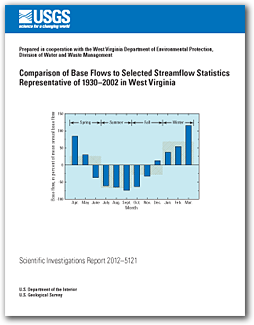 Abstract
Abstract
Base flows were compared with published streamflow statistics to assess climate variability and to determine the published statistics that can be substituted for annual and seasonal base flows of unregulated streams in West Virginia. The comparison study was done by the U.S. Geological Survey, in cooperation with the West Virginia Department of Environmental Protection, Division of Water and Waste Management. The seasons were defined as winter (January 1–March 31), spring (April 1–June 30), summer (July 1–September 30), and fall (October 1–December 31).
Differences in mean annual base flows for five record sub-periods (1930–42, 1943–62, 1963–69, 1970–79, and 1980–2002) range from -14.9 to 14.6 percent when compared to the values for the period 1930–2002. Differences between mean seasonal base flows and values for the period 1930–2002 are less variable for winter and spring, -11.2 to 11.0 percent, than for summer and fall, -47.0 to 43.6 percent. Mean summer base flows (July–September) and mean monthly base flows for July, August, September, and October are approximately equal, within 7.4 percentage points of mean annual base flow. The mean of each of annual, spring, summer, fall, and winter base flows are approximately equal to the annual 50-percent (standard error of 10.3 percent), 45-percent (error of 14.6 percent), 75-percent (error of 11.8 percent), 55-percent (error of 11.2 percent), and 35-percent duration flows (error of 11.1 percent), respectively. The mean seasonal base flows for spring, summer, fall, and winter are approximately equal to the spring 50- to 55-percent (standard error of 6.8 percent), summer 45- to 50-percent (error of 6.7 percent), fall 45-percent (error of 15.2 percent), and winter 60-percent duration flows (error of 8.5 percent), respectively.
Annual and seasonal base flows representative of the period 1930–2002 at unregulated streamflow-gaging stations and ungaged locations in West Virginia can be estimated using previously published values of statistics and procedures.